Guest author: Laura Campbell is Rank Ranger’s Digital Marketing Manager, Editor-in-Chief and Social Media maven
I love Google’s SERP features, they’re helpful, interesting, and purposeful. That doesn’t mean that they don’t at times pose a challenge to you and your site. In fact, Google’s long list of SERP features often place extra demands on us in order to stay in the site traffic hunt. Though, what if these demands were different depending on the industry of your site? Would that matter in terms of how you went about the business of ranking on the Google SERP? It surely would, let me show you how!

Not all Niches Are Equal When It Comes to SERP Features
Tracking Google’s SERP features, whether their overall trends or in the context of your own site, is important. We all want to know if we’re scoring the top spot in a Local Pack or if Google is showing your content within a Featured Snippet. For each SERP feature there is a unique scoring strategy. There are also a set of what I’ll call ‘consequences’ as well.
Simply, if you’re a local eatery, the most coveted feature is surely the Local Pack. Appearing within it can mean a big boost to site and store traffic. It also means that you need to make sure that Google has all of your information. If your local citation is inadequate in any way, well then Google won’t place your site within a Local Pack, and you may not have the desired level of site traffic or even physical traffic.
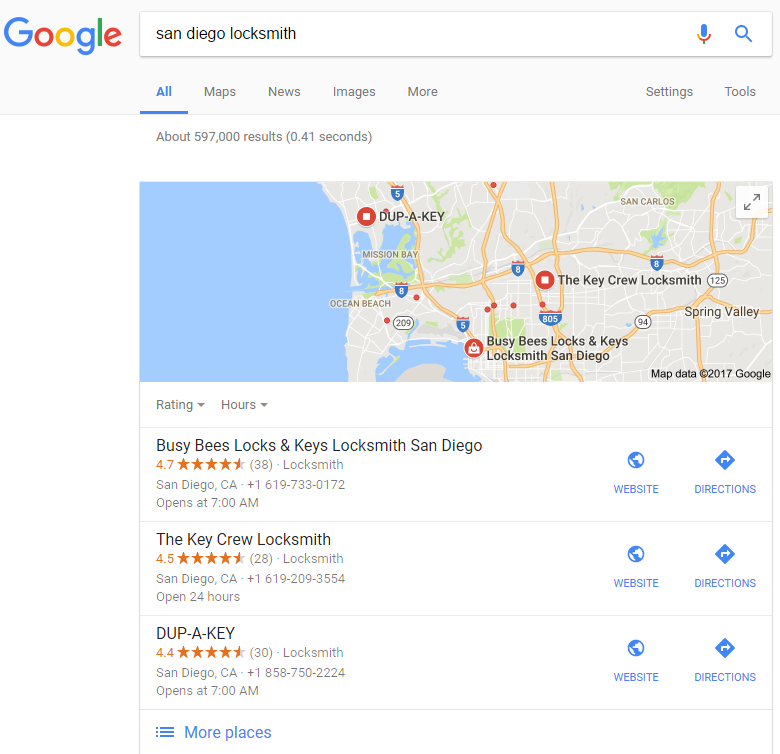
A typical Local Pack showing a map, three local results, user ratings, etc.
Local Packs though are not equally common across all industries. If you’re in an industry where a Local Pack appearing is a rare occurrence, then your local citation may not be your biggest concern. While I would never advocate not caring for your local citation properly, there may be bigger fish to fry. For your niche it could be that reviews are more common than in other niches, and you should act accordingly. It could be that your niche is predisposed to Featured Snippets, or Related Questions, or whatever. The point is, not every niche is equal when it comes to SERP features and there can be big implications for not knowing your niche’s trends.
While there are too many niches to present here, I will show you how being in different industries can have unique implications by looking at our SERP feature niche data from June 2017. To do this, I will focus on the Arts & Entertainment, Recreation & Sports, and the Financial Services & Personal Finance industries and present their varied SERP feature trends and the impact of those trends on a site’s ranking strategy. I chose the Financial Services & Personal Finance since in many ways it is the polar opposite of the other two niches. This way we can see just how Google responds to the varied nature of the different niches.
Featured Snippets – Location and Niche Matter for Position Zero Ranking
Let’s start with the most talked about SERP feature out there, Featured Snippets. Since the feature both appears above all other organic results, and since a site’s URL appears within it, Featured Snippets are highly coveted. Appearing within a Featured Snippet depends on a variety of elements. One of which is the position of your site on the SERP. Except that position varies across the niches.
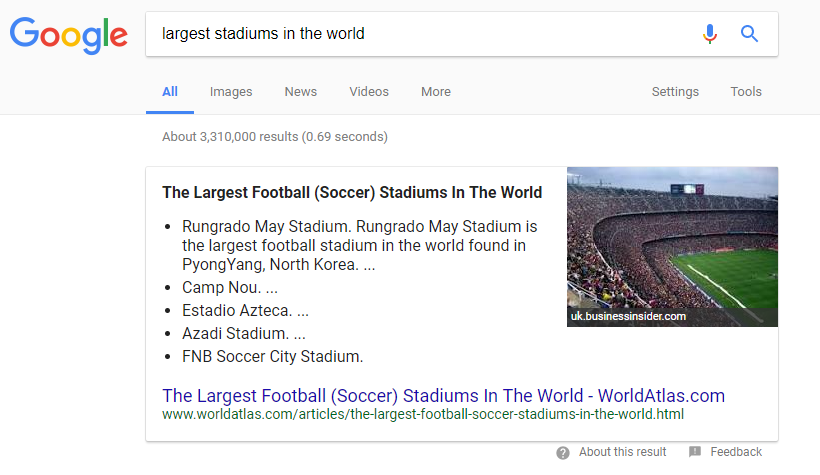
A Featured Snippet showing a bulletted list of information above the site’s URL, with a second site sourced for the image
Have a look at Arts & Entertainment, sites that ranked in position 1 on the SERP dominate Featured Snippets. In June 2017, roughly 40% of all Featured Snippets within the niche came from the top ranked site on the SERP.
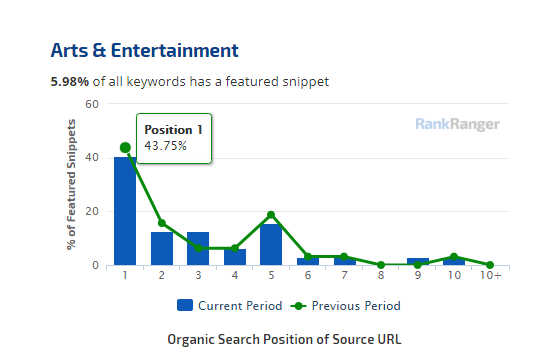
Of all the Featured Snippets within the Arts & Entertainment niche, 43.75% of them came from the top site on page one of the SERP
This may not be surprising. Across all of the niches, Google highly favors the top ranked site over any other for its Featured Snippet feature.
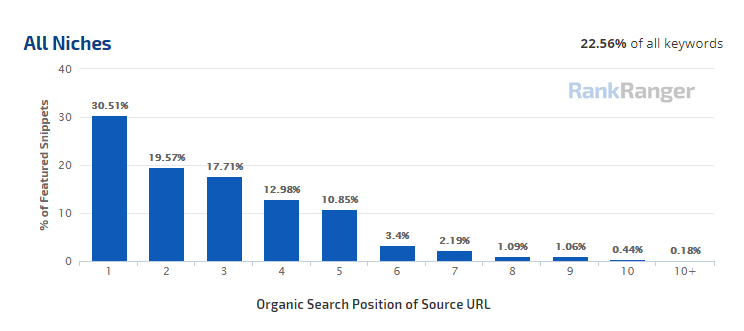
When looking for content to place within a Featured Snippet, Google strongly favors the top position on the SERP
That is, until we get to the Financial Services & Personal Finance industry. Here, the difference between the percentage of Featured Snippets from the #1 and #2 site on the SERP is not drastic at all. While 29% of Featured Snippets came from the top spot on the SERP, a very close 25% came from the second position.
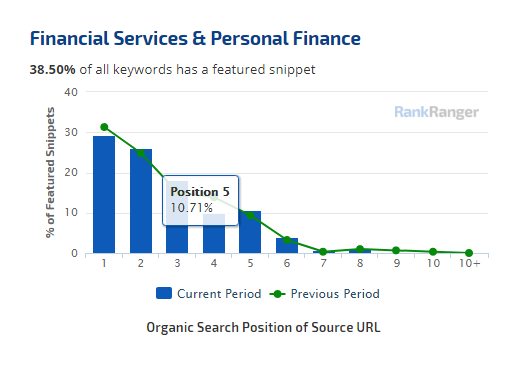
The Financial Services & Personal Finance niche bucks the trend with the second result showing within nearly as many Featured Snippets as the first
Why It Matters:
Knowing that your site needs to be all but at the top of the organic results to score a Featured Snippet makes ranking #1 on the SERP all the more important and competitive. Those within the Financial Services & Personal Finance industry can breathe just a little bit easier. Instead of focusing on hitting # 1 on the SERP, you should make sure your other page one results are Featured Snippet ready. This means that sites within the Financial Services & Personal Finance sector should take advantage of Google’s pattern. They should ensure that pages that rank in a multitude of positions contain content that is suitable for a Feature Snippets. (For more on how to score a Featured Snippet, see our Complete Guide to Featured Snippets).
I’ll take this one step further. The Arts & Entertainment only shows a Featured Snippet for about 6% of queries. That’s close to 550% less than the Financial Services & Personal Finance niche’s appearance for 38.5% of its queries. We all have limited resources and time. Perhaps if I was in the Arts & Entertainment industry, my time would be better spent on other Google SERP features. Not so within the Financial Services & Personal Finance, here Featured Snippets would be at the top of my priority list.
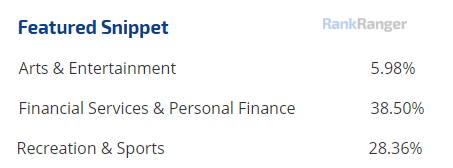
People Also Ask – Just Not in Every Industry
People Also Ask, also known as Related Questions, are the flipside of Featured Snippets. In fact, they are Featured Snippets in a way. They look like Featured Snippets, they contain the same type of information, etc. Here though, Google presents a series of questions related to the current SERP query. The questions can be expanded to reveal an answer, which is a Featured Snippet. Meaning, it’s a snippet of content from a site along with that site’s URL.
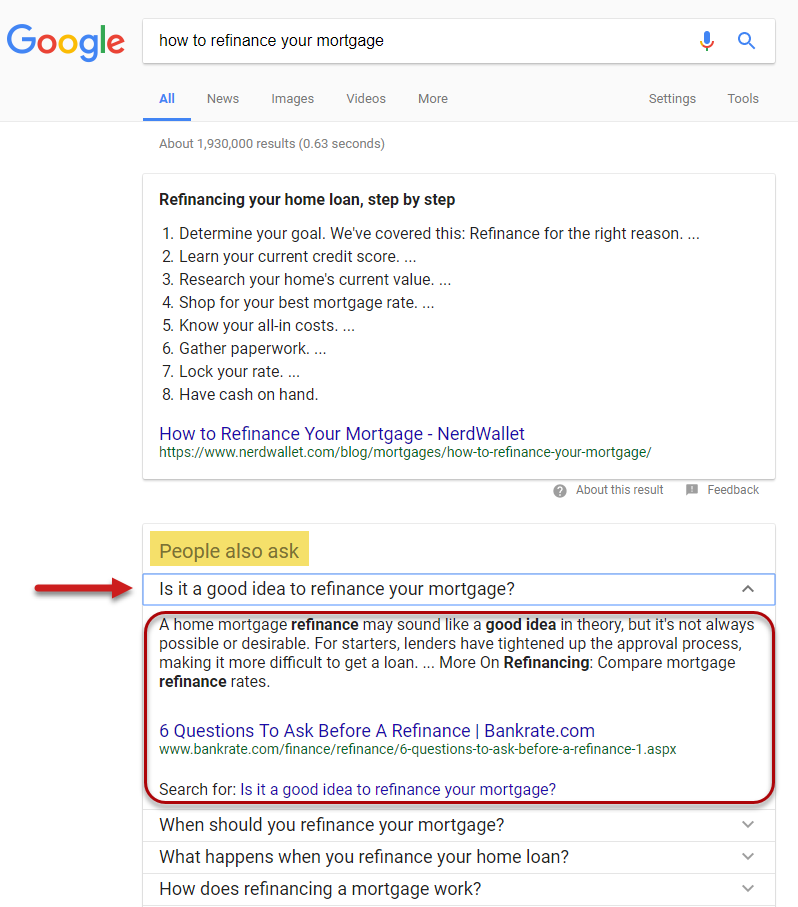
The Related Questions feature appearing under a Featured Snippet for a query within the Financial Services & Personal Finance niche
This means that while your site might not score a Featured Snippet, optimizing for one could mean your site appears as an answer within the Related Questions feature. Doing so is not a quick tweak or two. It requires time and knowhow. Would it be worth it if the feature only appears on the SERP for just over 7% of all queries within the niche? Maybe not, or at least not in a high priority kind of way. That’s the percent of People Also Ask dynamic boxes showing on of the SERP for keywords within the Arts and Entertainment industry.
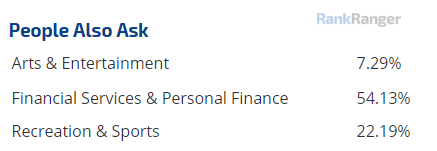
As you can see above, that’s not the case for the Financial Services & Personal Finance niche. Here the majority of results have the Related Questions feature on the page. That’s still 60% more frequent than the Recreation & Sports niche where the feature is carried on 22% of results. Clearly, Google related to the Financial Services & Personal Finance niche a bit differently, and such sites should act accordingly by optimizing their content for the feature and making the optimization process a priority.
Paid Search Competition – Where Sites Have Room to Succeed
Shifting gears a bit, let’s see how Google treats the different niches as it pertains to paid search. Such data is important, as an entire PPC strategy may depend on it.
Of the three niches under review, Financial Services & Personal Finance has considerably more keywords resulting in ads, 82% more when compared to Recreation & Sports. Both the Arts & Entertainment and Sports & Recreation niches significantly underperform Financial Services & Personal Finance when it comes to paid search. Arts & Entertainment and Sports & Recreation display ads for just 3.18% and 1.73% of niche queries respectively. This is compared to 9.75% within the Financial Services & Personal Finance industry.
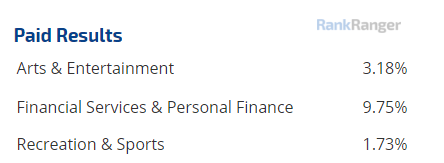
The data here matters. An industry with a higher AdWords display rate may be harder to break into. Meaning, there is much more paid search competition within Financial Services & Personal Finance niche when compared to the other two industries. With less paid competition within Arts & Entertainment and Sports & Recreation, there may be room for you to score some big PPC successes.
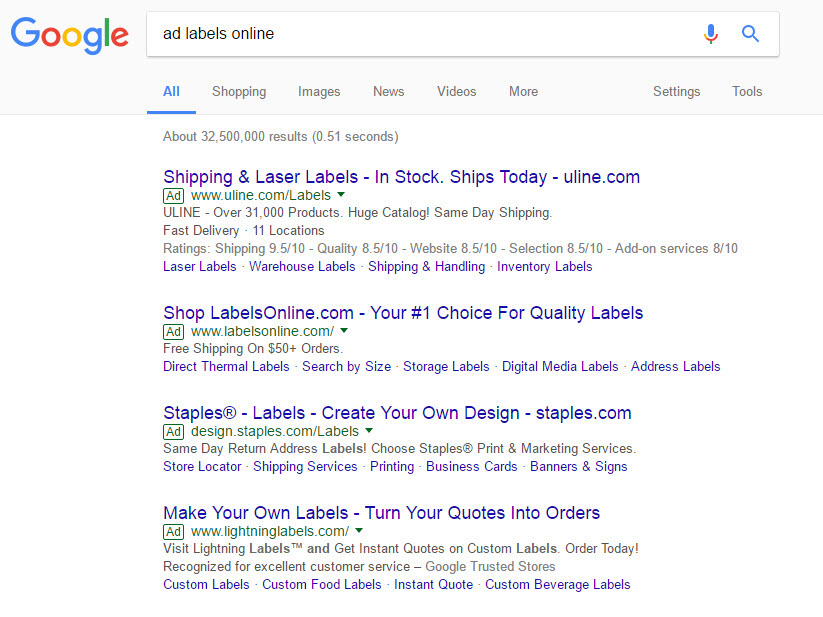
With the possibility of multiple ads pushing down the organic results, a good PPC strategy is often vital for success
Alternatively, seeing the higher rate of ad display within Financial Services & Personal Finance could mean the niche is ripe for PPC advertising. Though, armed with the knowledge that the niche shows heavy ad competition may require you rethink your approach. Certainly, you’ll have to very carefully consider your ad’s content and the keywords they target (among other things) if you want any chance at achieving success within such a niche.
Who Should Make Optimizing Images a High Priority?
If I had to list one the top areas where SEO is neglected, it would be image optimization. For a large portion of sites, images are accentuary, they are not the main content specimen. That is, many of us are not concerned if an image ranks well within Google’s image search.
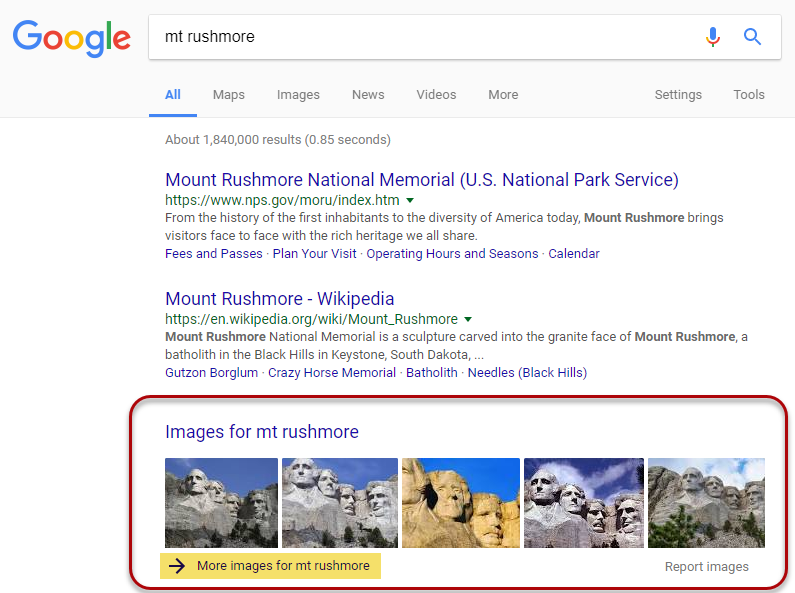
Google’s Image Box on the SERP shows multiple images as a preview to its full image search results
This too however is a general assessment, and practices should vary according to the niche. Obviously, an image related to a fixed rate mortgage is not as primary as one related to art history. This is why Google only displays an Image Box (a series of a images related to the search term) on a paltry 3% of SERPs within the Financial Services & Personal Finance niche. Here, and rightly so, it would seem that image optimization takes a back seat.
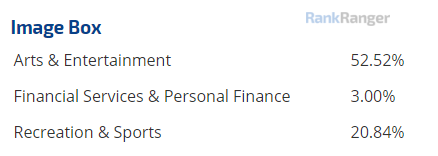
The same is not true for the Recreation & Sports industry, and especially not for the Arts & Entertainment industry. Google plasters its Image Box on nearly 21% and 53% of SERPs for each industry respectively. That’s a high display rate, even at 21%. This means that Google users will quite often see highly relevant, and highly optimized images within their results. Of course, in those instances, any site would hope it would be their image appearing as such. Sites within these two industries would certainly be wise to spend some significant time on the SEO of their images. Within the Financial Services & Personal Finance, sites may find better uses of their limited time, giving their images just the basics by way of optimization.
Google Reviews – Do They Matter for Some More Than Others?
How likely is it that a site you share the SERP with contains Google review stars? If a competitor did, and you did not, that would be a real disadvantage. While everyone in every industry should worry about obtaining positive reviews, the practice is more applicable for some than it is for others.
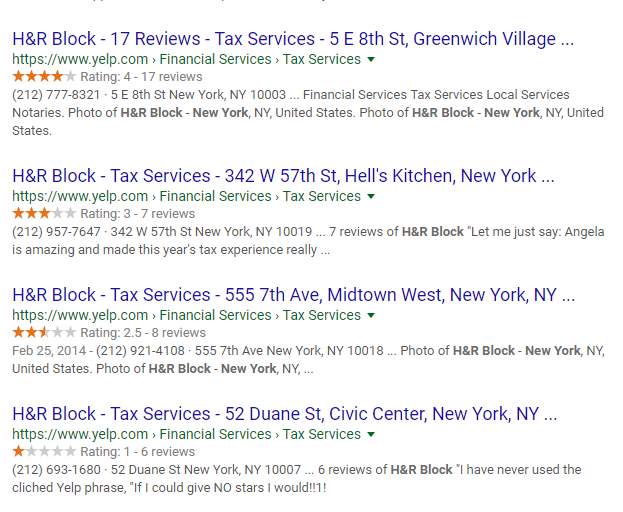
Ratings on the Google SERP for multiple New York H&R Block branches
For our purposes here, Google varies how often it shows Google Reviews within an organic result on the SERP across the niches. Both the Financial Services & Personal Finance and the Recreation & Sports industries show such ratings in at least 23% of SERPs. The Arts & Entertainment niche shows such ratings on just over 16% of all SERPs related to the industry category. When compared to Financial Services & Personal Finance that’s about a 73% differential.
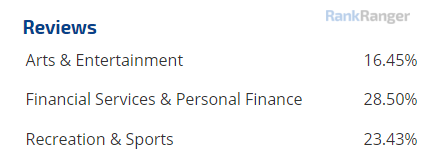
As I mentioned, anyone and everyone should be concerned with positive Google reviews. However, certain niches are more predisposed towards having their, or their competition’s ratings shown on of the SERP. Meaning, in certain industries reviews and ratings have more value and carry more weight.
I’m always very cautious about my financial planning, and my financial planners especially. If I were to look for such a professional or such a service online I would not even consider a site that did not have a rating, and a high one at that. Compare this to visiting an art museum. I may choose to kill a Sunday visiting a museum I found on the Google SERP, with or without a rating at all. When the stakes are higher, the ratings better be as well. If you’re in such an industry, having those high ratings appear on the SERP becomes paramount and should be a top SEO priority.
Carving A Niche
One of the unique things about SEO is that there’s a lot of information available to you. With the vast amount of content out there, it’s easy to lose sight of your data, your needs, and your niche. Universal tips, trends, and techniques are all well and good in the abstract. However, when dealing with the day in and day out of trying to get noticed on Google, it’s the peculiarities of your site, business, and niche industry that often matter most. Your SEO strategy should first and foremost consider your subjective scenario, a big part of which is how Google chooses to trend its SERP features for your industry. It’s all part of how you carve out a niche for yourself, and stay ahead of the competition.

About the Author
Laura Campbell is Rank Ranger’s Digital Marketing Manager, Editor-in-Chief and Social Media maven. Writing and marketing are Laura’s passions. She also enjoys working with Rank Ranger’s developers on ideas for new digital marketing reports and features that will make her job easier.
Social
![]()
![]()
